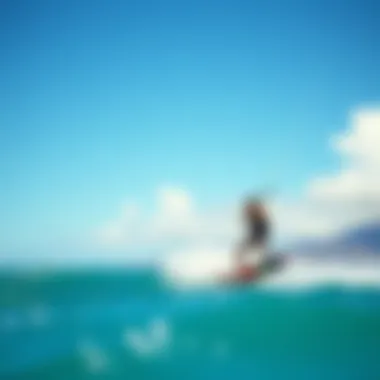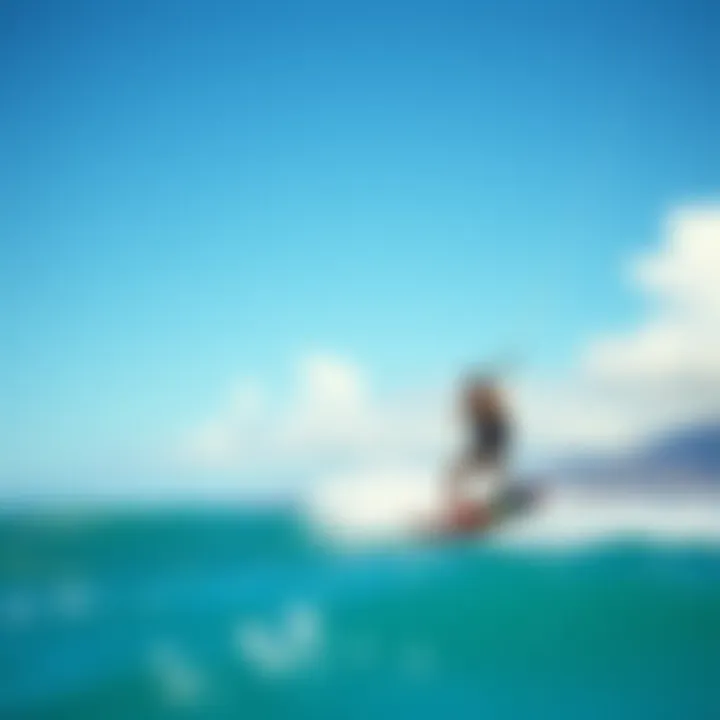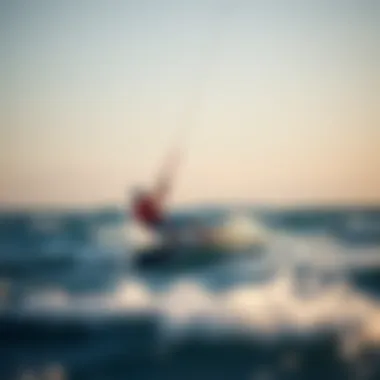Maui Satellite Weather Insights for Kiteboarding


Intro
Maui's charm is not just its stunning beaches and vibrant sunsets, but also its unpredictable weather patterns that can make or break a kiteboarding adventure. Understanding how satellite weather influences these conditions is crucial for both seasoned kiteboarders and newcomers alike. With the advent of satellite meteorology, getting a grasp on how wind dynamics shape the coastlines of Maui can greatly enhance one's experience on the water.
In this guide, we will take you through the labyrinth of Maui satellite weather, explaining its relevance not only to kiteboarders but also to instructors and enthusiasts who want to be in the know. We will walk you through the latest technological advancements in satellite weather, examine local weather patterns, discuss gear recommendations, and provide actionable techniques and tips for navigating the waters safely and effectively.
So, let's dive into the depths of this subject, shedding light on the practical applications of satellite weather data and overcoming the challenges that can arise during your kiteboarding escapades.
Prologue to Maui Satellite Weather
Understanding Maui's satellite weather is crucial for a mix of adventure seekers and sports enthusiasts, particularly kiteboarders. This area offers unique environmental elements shaped by its geography and climate. Knowing how to interpret satellite data can drastically improve the experience on the water, making it more enjoyable and safer in varying conditions.
For kiteboarders, especially, real-time weather data means knowing when to hit the waves or when to stay dry. Weather patterns in Maui can shift like a flag in the wind, and being in tune with these changes can mean the difference between a thrilling ride and an unanticipated downpour.
The Importance of Weather Data for Kiteboarding
Did you ever think about how the wind feels like an old friend one moment and a rogue wave the next? That’s the beauty and unpredictability of kiteboarding, particularly in Maui's spectacular waters. Weather data delivers insights that enhance every kiteboarding session. By keeping a finger on the pulse of local conditions, kiteboarders can:
- Choose the right time to kite: Getting out when wind speeds are optimal ensures a more exhilarating experience. The thrill of harnessing the wind can't be overstated.
- Optimize safety: Knowledge of changing weather patterns supports better safety planning. Understanding potential storms can help in avoiding dangerous situations.
- Explore hidden gems: Some winds may be perfect for those who want to venture into less-traveled waters. The right data can lead to discovering new spots that suit various skill levels.
Overview of Satellite Meteorology
An understanding of satellite meteorology carries significance that goes beyond just watching the skies. This field involves the use of technology to observe and predict weather events. It draws upon several satellite types, each equipped with distinct capabilities to collect invaluable data.
The advancements in satellite technology are quite impressive. Both geostationary and polar-orbiting satellites paint an accurate picture of the atmosphere not just across Maui, but globally. They observe factors like cloud formations, wind patterns, and temperature variations. Here’s the kicker: satellites can transmit this data back faster than one can say "Hawaii"!
In a nutshell, satellite meteorology offers a bird’s-eye view of the weather—figuratively and literally—allowing kiteboarders to plan ahead and make the most of their time on the water. For those looking to dive deeper, check out resources like Wikipedia and sites dedicated to weather data.
How Satellite Weather Works
Understanding how satellite weather functions is key for anyone looking to enjoy kiteboarding in the ever-changing conditions of Maui. With the breathtaking scenery and diverse wind patterns, knowing how these satellites gather data can help you make informed decisions about when to take to the skies. Satellite weather technology not only helps in predicting conditions but also in understanding the very fabric of our atmosphere.
Understanding Satellite Technology
To appreciate the intricacies of satellite weather, one must first grasp the fundamentals of satellite technology. Weather satellites orbit the Earth, gathering data from various altitudes and positions. Unlike traditional forecasting methods that rely heavily on ground data, satellites provide a bird's-eye view of atmospheric conditions. This high vantage point allows for real-time tracking of weather systems, from cloud formation to temperature fluctuations.
Satellites use sophisticated sensors to capture data. These may include infrared sensors that can detect thermal emissions from the Earth, or visible light sensors that detect reflected sunlight from clouds and the surface. Thus, they work around the clock, collecting data even when it’s dark on one side of the planet.
Types of Weather Satellites
There are two main categories of weather satellites: geostationary and polar-orbiting satellites.
- Geostationary Satellites: These satellites remain fixed over one position above the equator. They continuously monitor weather changes in a specific region, making them crucial for real-time tracking of weather phenomena like storms or hurricanes. For instance, the GOES (Geostationary Operational Environmental Satellites) series is vital for providing updated weather information for the United States and surrounding areas, including Hawaii.
- Polar-orbiting Satellites: These travel in a north-south orbit, passing over the Poles and covering different parts of the Earth as the planet rotates. They provide detailed, global views of weather patterns and are particularly useful for long-term climate studies. An example is the Suomi NPP satellite, contributing valuable insights into atmospheric conditions.
Data Collection and Transmission
The backbone of satellite weather systems lies in data collection and transmission. This process involves multiple steps to ensure accurate and timely weather updates.
Initially, the satellites collect data from their sensors, which might include temperature, humidity, wind speed, and cloud cover. This data is then transmitted back to ground stations using radio waves. The information is decoded and analyzed by meteorologists and computer systems. The amalgam of data from various satellites creates a comprehensive picture of atmospheric conditions, enabling more precise weather predictions.
After processing, this information is disseminated through various platforms, including websites, mobile apps, and even direct alerts for kiteboarders. It’s worth noting that while satellite data is invaluable, it’s merely a piece of the puzzle. Ground-based observations and historical weather data play a critical role in refining predictions for more accurate forecasts.


High-quality satellite data combined with local ground reports creates a reliable forecast that can mean the difference between a fantastic kiteboarding session and a washout.
In summary, understanding how satellite weather works can drastically improve your kiteboarding experience. Awareness of satellite technology, types of weather satellites, and the critical processes of data collection and transmission provides a solid foundation for interpreting weather data effectively.
Local Weather Patterns in Maui
Understanding the local weather patterns in Maui is crucial for kiteboarders and anyone engaging in outdoor activities. The intricate interplay of various factors, such as geography and climate, creates a unique weather tapestry that not only influences wind conditions but also impacts overall safety and enjoyment. Knowing these patterns equips kiteboarders with the necessary insights to optimize their experiences on the water.
Microclimates Influencing Conditions
Maui is home to diverse microclimates that can shift dramatically over short distances due to its varied topography. For example, the lush, tropical rainforest of Hana is worlds apart from the arid, volcanic landscapes of Haleakalā. Each area can experience distinct weather phenomena at the same time, showing just how vital it is to stay attuned to local conditions.
In practical terms, this means that while the weather might be perfect in one area for kiteboarding—say, on the North Shore—conditions could be completely unsuitable just a few miles down the road in Kihei. Factors like altitude, proximity to the ocean, and vegetation play significant roles in creating these microclimates.
Bullet points to keep in mind regarding Maui's microclimates:
- Elevation: Higher areas often experience cooler temperatures and increased moisture.
- Vegetation: Forested areas can trap heat, affecting wind patterns and humidity.
- Proximity to Water: Coastal areas generally have more stable wind conditions than inland locations.
Each of these aspects can drastically alter kiteboarding conditions, from the type of wind a rider experiences to the potential for sudden rain squalls.
Seasonal Variations and Trends
Like any other tropical paradise, Maui has seasonal variations that affect kiteboarding conditions throughout the year. Typically, the trade winds are strongest between May and September. During this period, the reliable winds can reach speeds of 15-25 knots, a kiteboarder's dream! On the flip side, from October to April, the winds may be more sporadic, creating challenges for planning sessions.
Overall, the seasonal changes cause:
- Increased warmth in summer: Ideal for long kiteboarding sessions with pleasant sea breezes.
- Winter swells and storm systems: These can disrupt wind patterns and cause rough waters, thus requiring caution.
- Fluctuating humidity levels: Higher during summer months which can affect thermal dynamics while riding.
Staying aware of these seasonal trends will help kiteboarders plan their adventures while ensuring that they capitalize on favorable conditions and avoid any pitfalls.
Impact of Trade Winds on Kiteboarding
The trade winds are a defining feature of Maui's weather, providing a consistent and reliable wind flow that kiteboarders depend on. These winds are primarily directed from the northeast, leading to ideal conditions on the North Shore and other areas where kiteboarding flourishes.
Notably, for kiteboarders, the benefits of trade winds include:
- Consistency: Trade winds often sustain a steady speed, allowing for more predictable riding conditions.
- Challenges: Riders must also be prepared for sudden wind shifts or gusts that can arise, particularly around certain geographical features.
- Safety considerations: It's important to understand how the trade winds interact with local topography, as wind shadows can create unexpected lulls and turbulence in certain spots.
"Knowledge of the trade winds is key; an understanding of their behavior ensures not only exhilarating rides but also prudent safety measures."
Reading Satellite Weather Data
Understanding how to read satellite weather data is pivotal for kiteboarders, instructors, and enthusiasts looking to maximize their time on the water. The ocean and wind conditions can shift rapidly in Maui's dynamic landscape, so having a firm grasp on how to interpret and utilize this data is essential. Satellite data provides a bird’s eye view of weather systems, allowing kiteboarders to make informed decisions and improve safety and performance.
Interpreting Weather Maps
Weather maps sourced from satellite imagery provide a visual representation of current conditions and forecasted changes. Key elements to focus on when interpreting these maps include:
- Isobars: These lines indicate areas of equal atmospheric pressure. Close isobars signify strong winds, which are crucial for kiteboarding.
- Fronts: Cold fronts can bring sudden changes in weather; recognizing them allows kiteboarders to prepare for possible shifts in wind direction and intensity.
- Temperature Gradients: These can indicate how different air masses interact, affecting local wind patterns. Variations in color on the map often represent these gradients.
Learning to read these features helps kiteboarders anticipate conditions, ultimately enhancing their safety and enjoyment.
Understanding Cloud Cover and Patterns


Cloud cover and types of cloud formations directly affect visibility and wind conditions, which are critical components for kiteboarding. Here’s how to analyze them:
- Cloud Types: Different clouds indicate varying weather scenarios. Cumulus clouds typically signify fine weather, while stratus clouds may bring overcast skies and light precipitation.
- Coverage: High cloud coverage can dampen sunlight, making conditions cooler. On the other hand, clear conditions are often more stable and favorable.
- Movement Patterns: Observing how quickly and in what direction clouds shift can give insight into changing weather. Rapidly moving clouds could signal incoming wind shifts or storms.
All these elements combine to help kiteboarders predict performance and prepare for their sessions effectively.
Analyzing Wind Speed and Direction
Wind speed and direction are arguably the backbone of kiteboarding. Understanding data related to these aspects allows enthusiasts to plan optimal sessions:
- Satellite Measurements: Wind data gathered from satellites can include speed and preferred directions, usually represented in graphs or colored gradients on maps.
- Anemometers and Buoys: Combining satellite data with local instruments can enhance accuracy. Using both allows kiteboarders to verify conditions, accounting for local geographic influences that satellites might miss.
- Wind Patterns: Identifying consistent wind patterns, influenced by Maui’s topography, can help predict more reliable conditions for future kiteboarding endeavors.
In essence, being savvy about reading satellite weather data arms kiteboarders with vital knowledge. It not only enhances their enjoyment of the sport but also instills a greater sense of safety on the water. As with anything, practice makes perfect, and regularly checking satellite data will bolster decision-making skills over time.
"Knowledge is power, especially when it comes to predicting the winds and waves. One bad day on the water can steer you away from your passion."
For more in-depth information, visit resources like Wikipedia, National Oceanic and Atmospheric Administration, or meteorology forums on Reddit. These resources can provide additional insights into interpreting satellite weather data effectively.
Practical Applications of Satellite Weather for Kiteboarding
Understanding satellite weather is crucial for kiteboarders looking to make the most of their time on the water. The intersection of technology and outdoor recreation provides an avenue for kiteboarders to plan their outings with precision and confidence. Accessing accurate weather data transforms the experience from mere guesswork into an informed adventure, enabling enthusiasts to enjoy the thrill while minimizing risks. Here are some practical applications that can enhance your kiteboarding experience in Maui.
Planning Kiteboarding Sessions
When it comes to planning your kiteboarding sessions, the importance of understanding satellite weather cannot be overstated. For the best experience, kiteboarders should pay attention to:
- Wind Conditions: Satellite data helps kiteboarders track wind speeds and directions, crucial for determining the best times to hit the water. Whether you prefer a light breeze for a leisurely ride or stronger winds for akrobatics, having up-to-date information is vital.
- Tides: Understanding the tidal patterns is essential as they can significantly affect the water conditions. Satellite data can provide insights on tidal movements, helping you avoid rough waters that could hinder your performance.
- Seasonal Trends: Different seasons in Maui bring varying wind and weather patterns. Using historical satellite data, you can identify the best months to kiteboard, ensuring your trips coincide with optimal weather conditions.
By taking these factors into account, you can plan sessions that align with both your skill level and preferred kiteboarding style.
Safety Considerations Based on Weather Data
Safety should always be a top priority for kiteboarders. With reliable satellite weather data, you can make more informed decisions that enhance your safety while out on the water. Some considerations include:
- Severe Weather Alerts: Satellite technology provides timely reports on potential storms or significant weather changes. Being aware of a sudden squall can make a world of difference in avoiding dangerous situations.
- Visibility Conditions: Fog and cloud cover can quickly reduce visibility. Keeping an eye on satellite data allows the kiteboarder to assess these factors before heading out, ensuring they choose safe conditions.
- Temperature Changes: Weather patterns can shift rapidly, changing water temperatures. Understanding how these fluctuations affect both equipment and personal safety is crucial for a pleasant experience.
By being aware of and acting based on current weather conditions, kiteboarders can make smart choices and potentially save themselves from hazards.
Real-time Weather Apps and Tools
In today’s digital age, lightweight applications powered by satellite data have revolutionized how kiteboarders interact with weather information. A few recommended tools include:
- Windy: This app provides comprehensive weather forecasts and real-time data on wind and water conditions using satellite imagery.
- KiteMap: A specialized tool that focuses on wind conditions at popular kiteboarding spots. It gathers live data, assisting kiteboarders in finding the ideal location based on current conditions.
- Weather Underground: Known for its detailed local weather reports, this app utilizes satellite data to provide real-time weather updates, keeping you informed wherever you are.
Leveraging these apps, kiteboarders can not only plan but also adjust their sessions on-the-go, taking advantage of the most up-to-date weather insights.
Utilizing satellite weather effectively allows kiteboarders to enjoy their sport more safely and enjoyably.
Challenges in Satellite Weather Interpretation
Understanding satellite weather in Maui comes with its own set of challenges. For kiteboarders and outdoor enthusiasts, the stakes are high; bad weather can quickly turn a thrilling adventure into a dangerous situation. To navigate this landscape effectively, it’s vital to grasp the complexities and limitations surrounding satellite data interpretation.


Limitations of Satellite Data
Despite the impressive technology behind satellite weather systems, these tools are not without their flaws. Here are some noteworthy limitations:
- Resolution Issues: Satellite imagery can often be low-resolution, especially for larger areas. This can obscure important details about local conditions. Finding out that it’s not just cloudy but also rainy in a specific pocket can turn your kiteboarding day upside down.
- Lag in Data Delivery: Because of the time it takes to collect and process satellite data, there can be delays. This means the information you receive may not represent the current weather accurately. What’s happening right now may not show up until after you've made plans.
- Atmospheric Interference: Factors such as humidity and airborne particles can distort satellite signals, leading to inaccurate readings. Sometimes, the sky can look clear on your screen, but that doesn’t mean the wind is playing nice.
It's critical for kiteboarders to recognize these limitations. Ignoring them could lead to underestimating the conditions on the water. Being aware can help in making informed decisions about when to hit the waves.
Common Misunderstandings of Weather Forecasts
Weather forecasts are often seen as gospel truth, but many kiteboarders may not fully understand their nuances. Some common misunderstandings include:
- Forecast Accuracy: Many people believe forecasts are 100% reliable, whereas they can sometimes miss the mark. Various factors can change—like the sudden appearance of localized storms—that often defy prediction. This unpredictability can affect planning.
- Wind Speed Interpretation: Misconceptions surround what wind speeds mean in practical terms. A forecast may say there’s a 15-knot wind, which sounds perfect, but if it’s gusty, it can be chaotic out there. Just because the numbers are right doesn’t always mean the conditions are fit for kiteboarding.
- Regional Variability: Weather can vary significantly within Maui itself, leading to confusion about how it impacts individual locations. An area that looks sunny and calm on a forecast might be a gusty nightmare just a few miles away.
Kiteboarders should be mindful of these common pitfalls. Engaging with local knowledge, checking real-time updates from trusted sources, and understanding the tools will help mitigate the risks associated with weather misinterpretations.
"Understanding the limitations and common pitfalls of satellite weather data allows kiteboarders to make smarter, more informed decisions on the water. Always remember: knowledge is power—especially in the face of changing weather conditions."
By learning the challenges of satellite weather interpretation, kiteboarders can enhance their experiences and stay safe. A solid grasp of these topics will not only elevate one’s skills but also sow a deeper appreciation for Maui's dynamic weather patterns.
The Future of Satellite Weather Technology
The landscape of satellite weather technology is rapidly changing, and this transformation holds significant implications for those keen on understanding and harnessing weather data, particularly for kiteboarding enthusiasts in Maui. As satellite technology advances, these changes can lead to more precise forecasting, improved data accessibility, and the potential for more personalized weather reports. This evolution emphasizes the necessity for kiteboarders to stay informed, adapting to the forthcoming changes which promise to enrich their experiences on the water.
Advancements in Satellite Capabilities
Imagine a scenario where weather data is available at your fingertips in real-time, making kiteboarding decisions not just a shot in the dark but a well-informed action. These advancements are not merely pie-in-the-sky; they are very much in the realm of possibility.
- Higher Resolution Imagery: Modern satellites are being equipped with superior imaging technology that allows for more detailed weather pattern analysis. This can lead to better forecasting accuracy, crucial for kiteboarding conditions where winds and weather change on a dime.
- Improved Data Processing: With enhanced algorithms and machine learning capabilities, processing weather data has become swifter and more efficient. As a result, kiteboarders can access updated information without the wait typical of older systems.
- Enhanced Communication Metrics: Satellite capabilities are expanding to include better communication techniques. This means that weather warnings can be dispatched quickly and effectively to end users, allowing for timely decisions during kiteboarding sessions.
These capabilities will not only boost kiteboarding experiences but also help in risk management, making for safer adventures on Maui’s waters.
Potential Impacts on Kiteboarding
Needless to say, the forward march of satellite technology will bring about transformative changes in how kiteboarders operate. With these advances, a few notable impacts may include:
- More Accurate Wind Forecasts: Kiteboarding essentially revolves around wind. The ability to predict wind patterns with improved accuracy can turn an average kiteboarding day into an extraordinary one. Predicting gusts and lulls accurately can help enthusiasts choose the perfect time to hit the waves.
- Localized Weather Insights: As these advancements unfold, the granularity of data available for specific locations, like Maui, will improve. This insight can be indispensable for kiteboarders looking not just at general forecasts but at data tailored to their exact spot on the island.
- Real-time Alerts: The possibility of receiving immediate alerts about changing weather conditions can safeguard kiteboarders. Whether it’s an incoming squall or a sudden wind shift, real-time notifications make for informed decisions that could avoid hazardous situations.
As we stand on the brink of this exciting future, kiteboarders are urged to embrace these changes. Learning about satellite weather technology not only enhances understanding but also augments the quality of one's kiteboarding ventures in the spectacular yet unpredictable environment that Maui offers.
Staying ahead of the curve means knowing the weather like the back of your hand. Equip yourself with the latest info, and let the winds guide you safely over the waves.
By keeping an eye on how satellite weather technology evolves, the kiteboarding community stands to glean not only enjoyment but also safety and innovation in their sport.
The End
In wrapping up our exploration of satellite weather in Maui, it’s crucial to grasp just how tightly woven this topic is with the experiences of kiteboarders and outdoor adventurers alike. The role that satellite technology plays cannot be overstated; it arms enthusiasts with a wealth of information that can significantly enhance their time on the water. By understanding the nuances of how satellites collect and transmit data, along with local weather patterns unique to Maui, kiteboarders are better prepared to choose the perfect days for their adventures.
Key Takeaways on Maui Satellite Weather
- Understanding Technology: Knowing how different types of satellites function to monitor weather is paramount. This includes geostationary and polar orbiting satellites, each serving specific needs for weather observation.
- Local Microclimates: Maui features a myriad of microclimates influenced by its topography. For instance, the windward side experiences more moisture compared to the leeward areas. This can drastically impact conditions and should be a key element in planning.
- Data Interpretation: Kiteboarders should feel comfortable interpreting weather maps, cloud cover, and wind data. Familiarity with these aspects allows for smoother decision-making and can lead to safer and more enjoyable outings.
- Practical Use: Real-time weather tools and apps are invaluable for kiteboarders. Utilizing these resources effectively can make the difference between a day filled with thrill or one with regrets due to poor weather choices.
Encouragement for Continued Learning
For anyone engaged in kiteboarding in Maui, the learning should never stop. The landscape and weather are dynamic, so staying updated with the latest in satellite weather technology and interpretations can provide a significant edge. Workshops, online courses, and community forums can be great avenues for expanding one’s knowledge.
"The more you know, the better you can navigate the winds and waters of Maui!"
Utilizing resources like en.wikipedia.org, reddit.com, and various educational sites can enhance understanding and keep kiteboarders informed about changing weather patterns. Continuous learning not only enriches one’s adventures but also builds a richer connection to the elements at play. It keeps kiteboarding exciting and full of possibilities well into the future.















